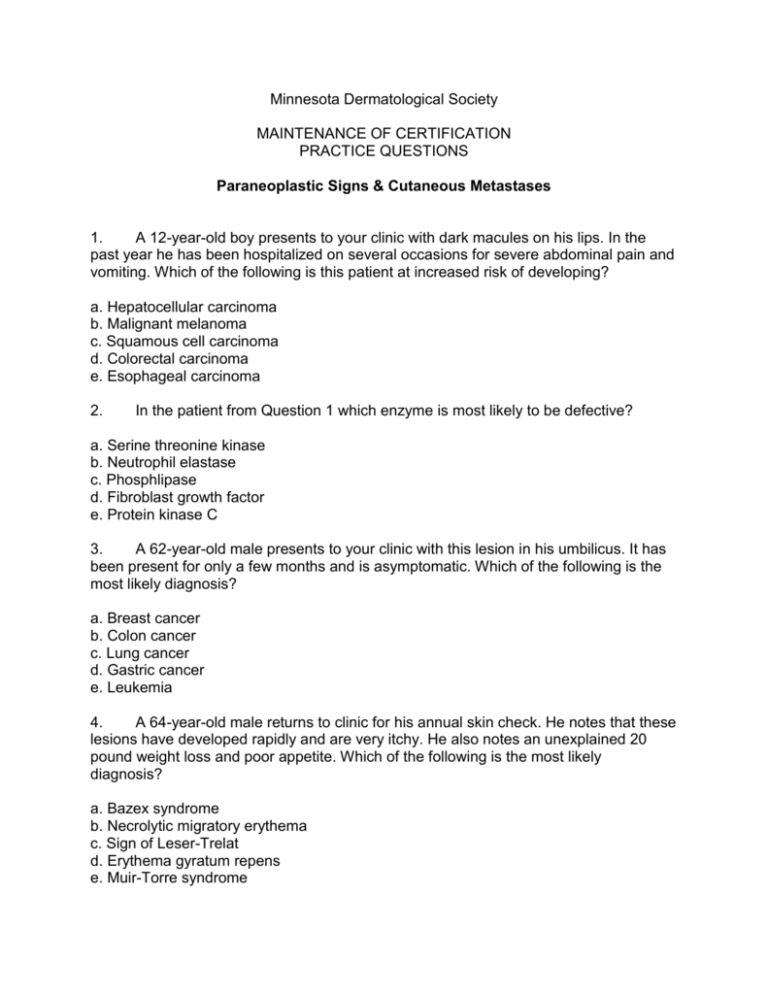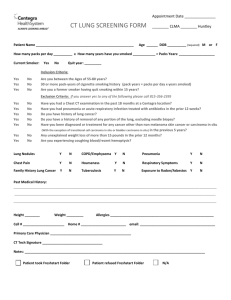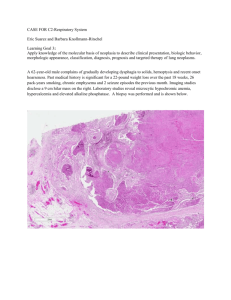Minnesota Dermatological Society / M.O.C. Questions / page 1 of 7
advertisement

Minnesota Dermatological Society MAINTENANCE OF CERTIFICATION PRACTICE QUESTIONS Paraneoplastic Signs & Cutaneous Metastases 1. A 12-year-old boy presents to your clinic with dark macules on his lips. In the past year he has been hospitalized on several occasions for severe abdominal pain and vomiting. Which of the following is this patient at increased risk of developing? a. Hepatocellular carcinoma b. Malignant melanoma c. Squamous cell carcinoma d. Colorectal carcinoma e. Esophageal carcinoma 2. In the patient from Question 1 which enzyme is most likely to be defective? a. Serine threonine kinase b. Neutrophil elastase c. Phosphlipase d. Fibroblast growth factor e. Protein kinase C 3. A 62-year-old male presents to your clinic with this lesion in his umbilicus. It has been present for only a few months and is asymptomatic. Which of the following is the most likely diagnosis? a. Breast cancer b. Colon cancer c. Lung cancer d. Gastric cancer e. Leukemia 4. A 64-year-old male returns to clinic for his annual skin check. He notes that these lesions have developed rapidly and are very itchy. He also notes an unexplained 20 pound weight loss and poor appetite. Which of the following is the most likely diagnosis? a. Bazex syndrome b. Necrolytic migratory erythema c. Sign of Leser-Trelat d. Erythema gyratum repens e. Muir-Torre syndrome Minnesota Dermatological Society / M.O.C. Questions / page 2 of 7 5. Which of the following internal malignancies is the patient from Question 4 most likely to have? a. Nasopharyngeal carcinoma b. Squamous cell carcinoma c. Acute myelogenous leukemia e. Gastrointestinal adenocarcinoma e. Breast carcinoma 6. A 60-year-old asian male is referred by his primary care physician for evaluation of these rapidly-changing patches. Patient is a heavy smoker. Which of the following is the most likely diagnosis? a. Psoriasis b. Erythema gyratum repens c. Eczema d.Contact dermatitis e. Tinea corporis 7. Which of the following internal malignancies is the patient from Question 6 most likely to have? a. Esophagal cancer b. Breast cancer c. Lung cancer d. Multiple myeloma e. Gastric cancer 8. A 42-year-old male returns to clinic for a follow-up exam for his psoriasis. The patient has been using Class I topical steroids on the lesions and has seen no improvement. Which of the following is the most likely diagnosis? a. Erythema Gyratum Repens b. Bazex syndrome c. Paraneoplastic pemphigus d. Dishydrotic eczema e. Tinea manuum 9. Which of the following cancers is the patient from Question 8 most likely to have? a. Laryngeal carcinoma b. Intraductal breast cancer c. Large cell lung cancer d. Small cell lung cancer e. Malignant melanoma Minnesota Dermatological Society / M.O.C. Questions / page 3 of 7 10. A 68-year-old female noticed this increased hair growth and an unexplained 30pound weight loss over the past year. Which of the following cancers is the patient at increased risk for developing? a. Pancreatic cancer b. Breast cancer c. Gastric cancer d. Brain tumor e. Colon cancer 11. Which of the following is the most common site of cutaneous metastases? a. Scalp b. Face c. Upper extemities d. Trunk e. Lower extremities 12. A 63-year-old female with a one-year history of poorly-controlled diabetes mellitus presents with these ulcerations on her lips, shins and groin. Which of the following tests would be the most reasonable next step? a. Complete blood count b. Fungal culture c. Patch test d. Computed tomography of abdomen e. Chest X-ray 13. In the scenario from Question 12 what would be the most likely diagnosis? a. Erythema gyratum repens b. Necrolytic migratory erythema c. Paraneoplastic pemphigus d. Cutaneous candidiasis e. Contact dermatitis 14. In the patient from Question 12 which symptom would you not expect? a. Hairloss b. Pruritis c. Anemia d. Thromboembolism e. Weight loss Minnesota Dermatological Society / M.O.C. Questions / page 4 of 7 15. A 79-year-old female complains of painful oral sores and blistering patches on her trunk. She has had both symptoms for two months. Which of the following is the most likely diagnosis? a. Paraneoplastic pemphigus b. Necrolytic migratory erythema c. Erythema multiforme d. Contact dermatitis e. Disseminated herpes simplex 16. Which of the following substrates used for indirect immunofluorescence would confirm the diagnosis of the patient from Question 15? a. monkey skin b. rat bladder c. pig skin d. monkey intestine 17. Which of the following is the most likely diagnosis from Question 15? a. Colon cancer b. Non-Hodgkin’s lymphoma c. Lung cancer d. Castleman’s disease e. Leukemia 18. The patient from Question 15 is at increased risk for which of the following?: a. Cardiac arrest b. Sepsis c. Respiratory failure d. Gangrene 19. A 56-year-old female with nipple discharge presents for evaluation of this unilateral patch that is mildly pruritic. Which of following is the mostly likely diagnosis? a. Pityriais rotunda b. Contact dermatitis c. Intertrigo d. Carcinoma erysipeloides e. Sweet’s syndrome 20. Which of the following internal cancers is the mostly likely diagnosis for the patient from Question 19? Minnesota Dermatological Society / M.O.C. Questions / page 5 of 7 a. Breast cancer b. Colon cancer c. Lung cancer d. Kidney cancer e. Gastric cancer 21. A 52-year-old male is referred to you by his primary physician for evaluation of ongoing pruritus. Patient says he itches all day long, and it is even worse at night. Your clinical examination, however, discovers no primary lesions. Which of the following is the most likely diagnosis? a. Colon cancer b. Leukemia c. Lymphoma d. Prostate cancer e. Lung cancer 22. A 46-year-old male is referred by his primary physician for removal of this rapidlygrowing lesion. It has been present for a few weeks and does not bleed with trauma. Which of the following is the most likely diagnosis? a. Renal cell carcinoma b. B-cell lymphoma c. Basal cell carcinoma d. T-cell lymphoma 23. A 70-year-old male with blisters and scarring on his conjunctiva is diagnosed with cicatricial pemphigoid. Which of the following autoantibodies, if detected, would indicate the patient is at increased risk of having an internal malignancy? a. Desmoplakin b. Anti-epilagrin c. Desmoglein d. c-ANCA e. p-ANCA 24. An 82-year-old male presents with three asymptomatic, rapidly-growing nodules on the scalp. Biopsy of the lesions indicates they are metastases of internal cancer. Which of the following is the most likely diagnosis? a. Lung cancer b. Gastric cancer c. Colon cancer d. Prostate cancer Minnesota Dermatological Society / M.O.C. Questions / page 6 of 7 25. A 55-year-old male presents with thickening on his palms and soles. On review of systems the patient acknowledges dysphagia and weight loss. The patient is diagnosed with Howell-Evans syndrome. Which of the following patterns best describes how this syndrome is inherited? a. Autosomal dominant b. Autosomal recessive c. Sporadic d. Imprinted e. Unknown References Patel, SG, Ahnen, DJ. Familial colon cancer syndromes: an update of a rapidly evolving field. Curr Gastrenterol Rep. 2012 632-637. Shah, KR, Boland, CR, Patel, M, Thrash, B, Menter, A. Cutaneous manifestations of gastrointestinal disease: part I. J Am Acad Derm 2013 189. Thiers, BH et al. Cutaneous Manifestations of Internal Malignancy. CA Cancer J Clin. 2009 59:73-98. Dar, I.H., Kamili, M.A., Dar, S.H., Kuchaai, F.A. Sister Mary Joseph nodule - A case report with review of the literature. J Res Med Sci. 2009 14:385-387. Gharwan, H. Gradon, J.G. Seborrheic keratoses of florid eruption. Case rep Oncol. 2012 5:576-579. Dourmishev, L.A., Draganov, P.V. Paraneoplastic dermatologic manifestation of gastrointestinal malignancies. World J Gastroenterol 2009 15:4372-4379. da Silva et al Paraneoplastic cutaneous manifestations: concepts and updates. An Bras Dermatol 2013 88:9-22. Halvorson, SA et al. Putting the pieces together: necrolytic migratory erythema and the glucagonoma syndrome. J Gen Intern Med 2013. Yosipovitch, G. Chronic pruritus: a paraneoplastic sign. Dermatol Ther 2010 23:590-596. Minnesota Dermatological Society / M.O.C. Questions / page 7 of 7 Abdull Gaffer et al. Post-mastectomy rash. Carcinoma erysipeloides. Int J Dermatol 2010 49:855-857. Cohen, PR. Lung cancer- associated scalp hair loss: a rare cause of secondary alopecia neoplastica. Cutis 2013 92:E7-E8. Saarinen, S. et al. Analysis of a Finnish Family confirms RHBDF2 mutations as the underlying factor in tylosis with esophageal cancer. Fam Cancer 2012 11:525-528 Young Al et al. Anti-laminin-332 mucous membrane pemohigoid asssociated with recurrent prostate carcinoma: hypothesis for a paraneoplastic phenomenon. Eur J Dermatol 2011 21:401-404.






